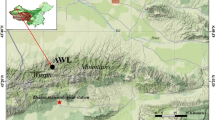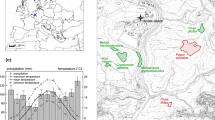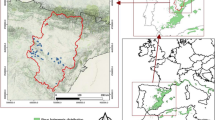Abstract
The gas-exchange and radial growth responses of conifer forests to climatic warming and increasing atmospheric CO2 have been widely studied. However, the modulating effects of variables related to stand structure (e.g., tree-to-tree competition) on those responses are poorly explored. The basal-area increment (BAI) and C isotope discrimination (C stable isotope ratio; δ13C) in the Mediterranean fir Abies pinsapo were investigated to elucidate the influences of stand competition, atmospheric CO2 concentrations and climate on intrinsic water-use efficiency (WUEi). We assessed the variation in δ13C of tree-rings from dominant or co-dominant trees subjected to different degrees of competition. A high- (H) and a low-elevation (L) population with contrasting climatic constraints were studied in southern Spain. Both populations showed an increase in long-term WUEi. However, this increase occurred more slowly at the L site, where a decline of BAI was also observed. Local warming and severe droughts have occurred in the study area over the past 30 years, which have reduced water availability more at lower elevations. Contrastingly, trees from the H site were able to maintain high BAI values at a lower cost in terms of water consumption. In each population, trees subjected to a higher degree of competition by neighboring trees showed lower BAI and WUEi than those subjected to less competition, although the slopes of the temporal trends in WUEi were independent of the competitive micro-environment experienced by the trees. The results are consistent with an increasing drought-induced limitation of BAI and a decreasing rate of WUEi improvement in low-elevation A. pinsapo forests. This relict species might not be able to mitigate the negative effects of a decrease in water availability through a reduction in stomatal conductance, thus leading to a growth decline in the more xeric sites. An intense and poorly asymmetric competitive environment at the stand level may also act as an important constraint on the adaptive capacity of these drought-sensitive forests to climatic warming.





Similar content being viewed by others
References
Andreu L, Planells O, Gutiérrez E, Helle G (2008) Climatic significance of tree-ring width and δ13C in a Spanish pine forest network. Tellus 60B:771–781
Bert D, Leavitt SW, Dupouey JL (1997) Variations of wood d13C and water-use efficiency of Abies alba during the last century. Ecology 78:1588–1596
Boisvenue C, Running SW (2006) Impacts of climate change on natural forest productivity-evidence since the middle of the 20th century. Glob Change Biol 12:1–12
Breiman L, Friedman J, Olshen R, Stone C (1984) Classification and regression trees. Wadsworth, Belmont
Burnham KP, Anderson DR (2002) Model selection and multimodel inference: a practical information-theoretic approach. Springer, Heidelberg
Canham CD, LePage PT, Coates KD (2004) A neighborhood analysis of canopy tree competition: effects of shading versus crowding. Can J For Res 34:778–787
Ceulemans R, Janssens IA, Jach ME (1999) Effects of CO2 enrichment on trees and forests: lessons to be learned in view of future ecosystem studies. Ann Bot 84:577–590
Drake BG, González-Meler MA, Long SP (1997) More efficient plants: a consequence of rising atmospheric CO2? Annu Rev Plant Physiol Plant Mol Biol 48:609–639
Duquesnay A, Breda N, Stievenard M, Dupouey JL (1998) Changes of tree-ring δ13C and water-use efficiency of beech (Fagus sylvatica L.) in north-eastern France during the past century. Plant Cell Environ 21:565–572
Farquhar GD, Richards RA (1984) Isotopic composition of plant carbon correlates with water-use efficiency of wheat genotypes. Aust J Plant Physiol 11:539–552
Farquhar GD, O’Leary HM, Berry JA (1982) On the relationship between carbon isotope discrimination and the intercellular carbon dioxide concentration in leaves. Aust J Plant Physiol 9:121–137
Feidas H, Noulopoulou N, Makrogiannis T, Bora-Senta E (2007) Trend analysis of precipitation time series in Greece and their relatioship with circulation using surface and satellite data: 1955–2001. Theor Appl Climatol 87:155–177
Feng X (1998) Long-term ci/ca responses of trees in western North America to atmospheric CO2 concentration derived from carbon isotope chronologies. Oecologia 117:19–25
Francey RJ, Allison CE, Etheridge DM, Trudinger CM, Enting IG, Leuenberger M, Langenfelds RL, Michel E, Steele LP (1999) A 1000-year high precision record of delta δ13C in atmospheric CO2. Tellus 51:170–193
Heaton THE (1999) Spatial, species, and temporal variations in the 13C/12C ratios of C3 plants: implications for palaeodiet studies. J Archaeol Sci 26:637–649
Hegyi F (1974) A simulation model for managing jack-pine stands. In: Fries J (ed) Growth models for tree and stand simulation royal college of forestry. Stockholm, Sweden, pp 74–90
Holmes RL (1983) Computer-assisted quality control in tree-ring dating and measurement. Tree-Ring Bull 43:68–78
Hultine KR, Marshall JD (2000) Altitude trends in conifer leaf morphology and stable carbon isotope composition. Oecologia 123:32–40
IPCC (2007) Climate change, fourth assessment report. Cambridge University Press, London
Jump AS, Hunt JM, Peñuelas J (2006) Rapid climate change-related growth decline at the southern range edge of Fagus sylvatica. Glob Change Biol 12:1–12
Körner C (2000) Biosphere responses to CO2 enrichment. Ecol Appl 10:1590–1619
Körner C (2003) Carbon limitation in trees. J Ecol 91:4–17
Linares JC (2008) Efectos del cambio global sobre la dinámica poblacional y la ecofisiología de bosques relictos de Abies pinsapo Boiss. PhD thesis. University of Jaén
Linares JC, Carreira JA (2009) Temperate-like stand dynamics in relict Mediterranean-fir (Abies pinsapo, Boiss.) forests from southern Spain. Ann For Sci 66:610
Linares JC, Camarero JJ, Carreira JA (2009) Interacting effects of climate and forest-cover changes on mortality and growth of the southernmost European fir forests. Glob Ecol Biogeogr 18:485–497
Lorimer CG (1983) Tests of age-independent competition indices for individual trees in natural hardwood stands. For Ecol Manage 6:343–360
Macias M, Andreu L, Bosch O, Camarero JJ, Gutiérrez E (2006) Increasing aridity is enhancing silver fir Abies alba (Mill.) water stress in its south-western distribution limit. Clim Change 79:289–313
Marshall JD, Monserud RA (1996) Homeostatic gas-exchange parameters inferred from 13C/12C in tree rings of conifers. Oecologia 105:13–21
McCarroll D, Loader NJ (2004) Stable isotopes in tree-rings. Quat Sci Rev 23:771–801
McNulty SG, Swank WT (1995) Wood 13C as a measure of annual basal area growth and soil water stress in a Pinus strobus forest. Ecology 76:1581–1586
O’Leary MH (1981) Carbon isotope fractionation in plants. Phytochemistry 20:553–567
Orwig DA, Abrams MD (1997) Variation in radial growth responses to drought among species, site, and canopy strata. Trees-Struct Funct 11:474–484
Panek JE, Waring RH (1997) Stable carbon isotopes as indicators of limitations to forest growth imposed by climate stress. Ecol Appl 7:854–863
Peñuelas J, Filella I (2001) Phenology: responses to a warming world. Science 294:793–795
Peñuelas J, Hunt JM, Ogaya R, Jump AS (2008) Twentieth century changes of tree-ring δ13C at the southern range-edge of Fagus sylvatica: increasing water-use efficiency does not avoid the growth decline induced by warming at low altitudes. Glob Change Biol 14:1–13
Picon C, Guehl JM, Ferhi H (1996) Leaf gas exchange and carbon isotope composition responses to drought in a drought-avoiding (Pinus pinaster) and a drought-tolerant (Quercus petraea) species under present and elevated atmospheric CO2 concentrations. Plant Cell Environ 19:182–190
Piovesan G, Biondi F, Di Filippo A, Alessandrini A, Maugeri M (2008) Drought-driven growth reduction in old beech (Fagus sylvatica L.) forests of the central Apennines, Italy. Glob Change Biol 14:1265–1281
R Development Core Team (2008) R: A language and environment for statistical computing. R Foundation for Statistical Computing, Vienna. ISBN 3-900051-07-0, http://www.R-project.org
Roden JS, Bowling DR, McDowell NG, Bond BJ, Ehleringer JR (2005) Carbon and oxygen isotope ratios of tree ring cellulose along a precipitation transect in Oregon, United States. J Geophys Res 110:1–11
Sarris D, Christodoulakis D, Körner C (2007) Recent decline in precipitation and tree growth in the eastern Mediterranean. Glob Change Biol 13:1–14
Saurer M, Siegwolf R, Schweingruber F (2004) Carbon isotope discrimination indicates improving water-use efficiency of trees in northern Eurasia over the last 100 years. Glob Change Biol 10:2109–2120
Seibt U, Rajabi A, Griffiths H, Berry JA (2008) Carbon isotopes and water use efficiency: sense and sensitivity. Oecologia 155:441–454
Sumner G, Homar V, Ramis C (2001) Precipitation seasonality in eastern and southern coastal Spain. Int J Climatol 21:219–247
Taylor AM, Brooks JR, Lachenbruch B, Morrell JJ, Voelker S (2008) Correlation of carbon isotope ratios in the cellulose and wood extractives of Douglas-fir. Dendrochronologia 26:125–131
Warren CR, McGrath JF, Adams MA (2001) Water availability and carbon isotope discrimination in conifers. Oecologia 127:467–486
Waterhouse JS, Switsur VR, Barker AC, Carter AHC, Hemming DL, Loader NJ, Robertson I (2004) Northern European trees show a progressively diminishing response to increasing atmospheric carbon dioxide concentrations. Quat Sci Rev 23:803–810
Willmott CJ, Rowe CM, Mintz Y (1985) Climatology of the terrestrial seasonal water cycle. Int J Climatol 5:589–606
Woodward FI, Bazzaz FA (1988) The responses of stomatal density of CO2 partial pressure. J Exp Bot 39:1771–1781
Wullschleger SD (1983) Biochemical limitations to carbon assimilation in C3 plants-a retrospective analysis of the A/C i curves from 109 species. J Exp Bot 44:907–920
Wullschleger SD, Tschaplinski TJ, Norby RJ (2002) Plant water relations at elevated CO2 implications for water-limited environments. Plant Cell Environ 25:319–331
Zweifel R, Zimmermann L, Zeugin F, Newbery DM (2006) Intra-annual radial growth and water relations of trees: implications towards a growth mechanism. J Exp Bot 57:1445–1459
Acknowledgments
This study was supported by Junta de Andalucía projects CVI-302, P06-RNM-02362 and RNM-296. J. C. L. acknowledges a MEC-FPU grant, and J. J. C. acknowledges the support of ARAID. We also want to thank Evan DeLucia and two anonymous reviewers for their helpful comments. These experiments comply with the current laws of Spain.
Author information
Authors and Affiliations
Corresponding author
Additional information
Communicated by Juan-Carlos Linares.
Electronic supplementary material
Below is the link to the electronic supplementary material.
Appendix
Rights and permissions
About this article
Cite this article
Linares, JC., Delgado-Huertas, A., Julio Camarero, J. et al. Competition and drought limit the response of water-use efficiency to rising atmospheric carbon dioxide in the Mediterranean fir Abies pinsapo . Oecologia 161, 611–624 (2009). https://doi.org/10.1007/s00442-009-1409-7
Received:
Accepted:
Published:
Issue Date:
DOI: https://doi.org/10.1007/s00442-009-1409-7




